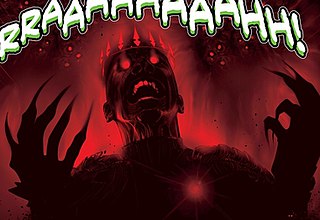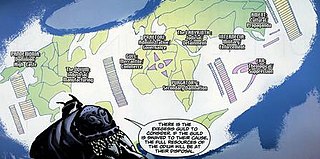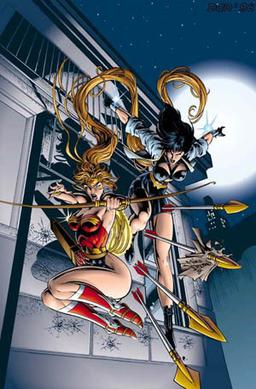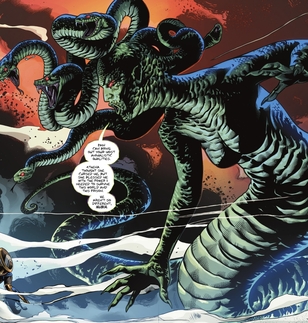
Neron is a supervillain appearing in various American comic book stories published by DC Comics. He first appeared in Underworld Unleashed #1 and was created by Mark Waid and Howard Porter.

Queen Hippolyta is a superhero appearing in American comic books published by DC comics, based on the Amazon queen Hippolyta from Greek mythology. Introduced in 1941 during the Golden Age of Comic Books, she is the queen of the Amazons of Themyscira, the mother of Wonder Woman, and in some continuities, the adopted mother of Donna Troy.

Artemis of Bana-Mighdall is a fictional Amazon superheroine and antihero, a comic book character published by DC Comics. The character was created by William Messner-Loebs and Mike Deodato, and debuted in Wonder Woman #90 as a rival to Princess Diana of Themyscira. Artemis had briefly succeeded Diana as the new Wonder Woman, but was later killed while assuming the role, fulfilling a prophecy of Wonder Woman dying. After her death, Artemis was sent to the Underworld, but eventually returned to the world of the living.

Etta Candy is a fictional character appearing in DC Comics publications and related media, commonly in association with Wonder Woman. Spirited and vivacious, with a devil-may-care attitude, Etta debuted as a young white woman with red hair in 1942's Sensation Comics #2, written by Wonder Woman's creator William Moulton Marston.

Circe is a fictional character appearing in DC Comics publications and related media. Based upon the eponymous Greek mythological figure who imprisoned Odysseus in Homer's Odyssey, she is a wicked sorceress and major recurring adversary of the superhero Wonder Woman. She has been presented variously since first appearing in 1949’s Wonder Woman #37, though her characterization has consistently retained a key set of features: immortality, stunning physical beauty, a powerful command over sorcery, a penchant for turning human beings into animals and often, a delight in humiliation.

Marduk Kurios is a character appearing in American comic books published by Marvel Comics. He is a demon who has repeatedly posed as Satan and is the father of Daimon Hellstrom and Satana Hellstrom.

Hades is a fictional character appearing in DC Comics publications and related media, commonly as an adversary and sometimes-ally of the superhero Wonder Woman. Based upon the eponymous Greek mythological figure, he is the Olympian god of the dead and ruler of the underworld.
The Olympian Gods are characters based upon classical mythology who appear primarily in Wonder Woman, Captain Marvel and Aquaman comics.

Orana is a fictional character who appears in comics produced by DC Comics. Orana is a red-haired Amazon who challenges and defeats Princess Diana for the title of Wonder Woman in WW issue #250. Orana adopts the self-imposed title as the "New Wonder Woman" and departs Paradise Island for New York City. She is killed in action shortly into her reign and allows Diana to reclaim the role as Wonder Woman.

Shim'Tar is a fictional character owned by DC Comics and was co-created by penciler Chris Marrinan and writer George Pérez. According to the Wonder Woman comic book, the name Shim'Tar can also be a title given to the chief warrior of the fictional Bana-Mighdall tribe of Amazons.

Tezcatlipoca is a name used by two distinct fictional characters appearing as supervillains in DC Comics publications and related media.

Mala is the name of two fictional characters who first appeared in the DC Comics' universe as two members of Wonder Woman's fellow Amazons.

"Gods and Mortals" is a seven issue comic book story arc plotted and drawn by George Pérez, with scripting by Greg Potter and Len Wein.
The Hellenders are a fictional comic book superhero team owned by DC Comics and created by writer William Messner-Loebs.

Hell is a fictional location, an infernal Underworld utilized in various American comic book stories published by DC Comics. It is the locational antithesis of the Silver City in Heaven. The DC Comics location known as Hell is heavily based on its depiction in Abrahamic mythology. Although several versions of Hell had briefly appeared in other DC Comics publications in the past, the official DC Comics concept of Hell was first properly established when it was mentioned in The Saga of the Swamp Thing #25–27 and was first seen in Swamp Thing Annual #2 (1985), all of which were written by Alan Moore and illustrated by Stephen Bissette and John Totleben.

Philippus is a fictional character created by DC Comics. She made her first appearance in February 1987 as an Amazon character in the Wonder Woman comic book. The character was created by writer/artist George Pérez.

The Contest is a comic book story arc that occurred in 1994 written by William Messner-Loebs and drawn by Mike Deodato. It compiled a segment of the second volume of the DC Comics Wonder Woman comic book from issues #90 through #93 and issue #0 into a collected book edition.

The Challenge of Artemis is a comic book story arc that occurred in 1995 written by William Messner-Loebs and drawn by Mike Deodato. It compiled a segment of the second volume of the DC Comics Wonder Woman comic book from issues 94 through 100 into a collected book edition.

Zola is a fictional DC Comics character, created by writer Brian Azzarello and artist Cliff Chiang. She first appeared in Wonder Woman #1, and since then as played an integral part in the series. Zola is featured as a young woman carrying Zeus' child, thus entering dangerous situations, the first one being of Hera aiming to punish her for sleeping with her husband. Wonder Woman takes Zola under her protection and tries to fight off forces that might try to harm her or her baby.

Medusa is a fictional character appearing in DC Comics publications and related media, commonly as a recurring adversary of the superhero Wonder Woman. Based upon the eponymous Greek mythological figure whose story was chronicled in Ovid's Metamorphoses, she is a snake-haired Gorgon with the ability to turn living creatures to stone with her gaze. Since her debut in 1964, Medusa's physical appearance has been presented variously as DC Comics' continuities have shifted and evolved. Though she has routinely been depicted with snakes for hair, she has sometimes been shown as bipedal and sometimes with a serpentine lower body. However across continuities, she has consistently been written with the ghostly ability to possess or influence other beings after her physical body has been killed, as well as an uncanny capacity for resurrection after death. Her characterization has been that of a dangerous immortal creature who is at turns both vengeful and sympathetic.



















